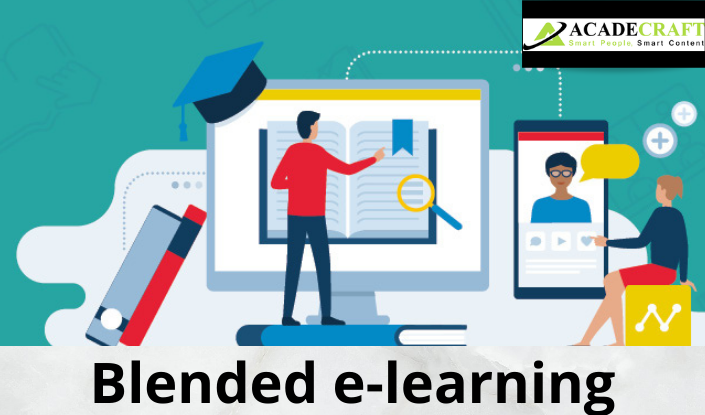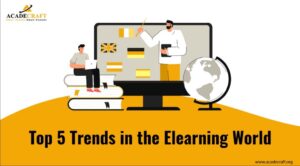Blended learning solutions are currently the burning topic of discussion in the education arena. Your institution also must have considered it at some point in time. Right? If yes, then you must be familiar with the challenges an organisation faces while implementing them. Is there any way to avoid those difficulties? Well, yes, there is. In this blog, we will discuss some tips to implement a successful blended learning strategy. But before that, let’s take a look at how Blended e-learning programs will help your institution.
Why Blended e-learning Solutions?
In simplest words, blended learning solutions bring the good of both online and offline learning modes. Hence, it is a vital mode for eliminating the shortcomings of classroom and online teaching methods. Take, for instance; you want to discuss a highly technical STEM topic with your learners. Now for such topics, your learners might not be interested in listening to a complicated technical lecture.
Instead, they would prefer viewing animated videos on the topic. It is where blended learning helps. Using blended learning techniques, the institutes can use some digital learning techniques in live classrooms. It helps to increase the efficiency of the classes.
Even in corporate training, blended learning methods are highly beneficial. Many companies use digital training modules during training sessions. Such modules are interesting, including the latest information, and help in increasing knowledge retention.
From the above discussion, a few points are pretty clear.
- Blended e-learning increases the efficiency of both online and offline learning.
- It increases learners’ engagement.
- And due to the reasons mentioned above, your course ratings and attendance rate will increase.
But, now let’s come back to the initial discussion we were having. Blended learning solutions are beneficial only if they are implemented successfully. For that, we will have to find ways to negate the challenges involved in it. What are the ways to do that? It’s time to unravel them for you!
6 Tips to Succeed in Blended e-learning Strategy
Though different institutes might have their own set of issues, some challenges are common for all. Some of the major challenges institutes face while implementing blended learning solutions are:
- Lack of infrastructure
- Failing to engage the remote learners
- Poor coordination of the instructors and blended learning solution designers
- Unavailability of teacher manuals for training of instructors
And there are many others as well. To combat these challenges, your institute requires efficient planning and a well-thought blended learning strategy. The professional blended learning solutions providers also help in designing the required solutions. To help you out, we are sharing these 6 tips to implement better blended learning solutions.
1. Define Learning Goals
In the first step, your institution must figure out the learning goals. By defining learning goals, we usually mean the following:
- Does your institute want to increase the overall learning experience of learners?
- Does your institute wish to increase the number of learners?
- Are you focusing on experiential learning?
Depending on your answers to the above-stated questions, the professional service providers will formulate the blended learning strategy for you.
2. Note Down Your Institute’s Limitations
Blended learning needs good infrastructure. The minimum necessity is projectors in every classroom and a good internet connection to operate the system. If your institution lacks this basic need, then you should not think of blended learning as yet. And then, do not forget that it is only the basics.
For implementing advanced blended learning solutions, your institute may need advanced technical equipment. So, before thinking of blended learning techniques, evaluating the limitations is a must.
Professional blended e-learning service providers will help you out. Their experts will survey your institute and note down the missing points. Accordingly, they will also suggest a list of blended learning solutions that you can actually implement successfully.
3. Understand Your Learner’s Preference
In blended learning, the collaboration between the instructors and learners is very important. So, to implement it successfully, you need to understand the preferences of your learners first. Conduct surveys. Ask them what type of blended learning activities they want to get involved in. By doing so, your institute will understand which solutions to implement and where.
Nowadays, even the service providing companies assist the institutes in this process. They first understand the learning needs of your learners and then suggest appropriate blended learning solutions.
4. Choose the Perfect Blend
Blending should be done cautiously. The institutes often blend so much that their offline classes are literally converted into movie theatres or virtual labs. You need to understand that too much of anything can be boring. In the hope of delivering blended e-learning, if you completely miss out on conventional classes, your learners will start missing the classroom interactions. So, you need to choose the perfect blend that balances both.
The professional service providers will help you out here. They will study your curriculum and design the perfect blended learning lessons to deliver the best possible results.
5. Train Your Instructors
Now, this point is quite important. Studies have shown that more than 50% of the blended learning strategies fail due to the failure of instructors. In many cases, it is seen that the instructors fail to handle the technology used for blended learning. Also, they often depend so much on blended e-learning techniques that they stop explaining things to learners.
So, to successfully implement the blended learning strategies, training your instructors is a must. And you don’t need to worry about that. The professional service providers will definitely help you with that.
6. Act on Feedbacks
Even after implementing the blended learning solutions, you might not achieve the desired results. In such cases, try to take feedback from your instructors and learners. Ask them for suggestions. And when they do suggest, try to act upon them. Trust us; it is one of the best ways to improve blended learning strategies.
To Sum Up
So, blended learning will help you to improve the learning experience of your learners by many folds. But, it has high chances of failure as well. To avoid that, you should follow the following steps:
- Carefully define your learning objectives.
- Be aware of what limitations your institute might face.
- Understand the needs and choices of your learners.
- Do not over blend. Try to strike the right balance.
- Train your instructors and take regular feedback from learners.
If you follow these tips, your blended learning success might increase. But, at the end of the day, it all depends on your blended learning service provider. So, if you need an efficient blended learning service provider, Acadecraft is right here for you. With years of experience in offering tailor-made blended learning solutions, we will help you craft the perfect strategy for your institution.







